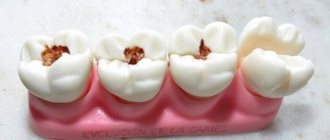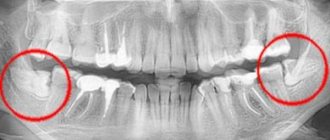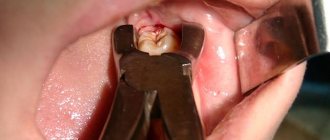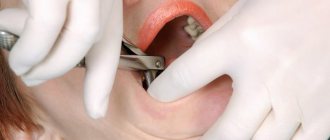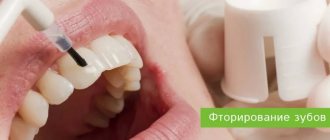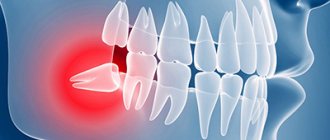In this article
- What is a wisdom tooth and where is it located?
- Why does figure eight caries occur?
- A wisdom tooth affected by caries - treat or remove?
- Pros and cons of treatment tactics for wisdom teeth for caries
- In what cases does wisdom tooth treatment make no sense and must be removed?
- Pros and cons of removal tactics for caries of the lower or upper eights
- Step-by-step treatment of wisdom tooth caries
- How is a wisdom tooth removed?
- Is it necessary to place an implant instead of a removed figure eight?
When caries is detected, there is usually no question of what to do. He is treated immediately. But if caries is found on a wisdom tooth, a person may be faced with a choice - to treat or remove it. We will tell you in this article how to deal with caries of eights correctly.
What is a wisdom tooth and where is it located?
The name “wisdom tooth” is assigned to the third molar, the so-called figure eight, the eighth tooth in a row. The period of wisdom teeth eruption is approximately from 20 to 27 years. In rare cases, they appear after 40 years. It is precisely with the age of eruption that the name of eights—“wisdom teeth”—is associated, because in fact they appear in a person during the period of maximum maturity of the body.
It is interesting that in some people, despite the presence of the rudiments of teeth, they may not erupt throughout their lives. Scientists explain this fact by the fact that in the process of evolution, modern people's jaw has become shorter by about 12 mm compared to their ancestors, which is due to softer food, when chewing which there is no heavy load on the jaw.
If figure eights do erupt, they often cause pain and discomfort to the person. If the jaw is small, then in the process of growth the eights can shift the dentition, which leads to the curvature of other teeth. Therefore, many people try to remove them whenever possible. But the very fact of having a “wise” tooth is not always a reason for its removal.
Myth four: electric brushes and irrigators loosen fillings
Modern technologies have brought a lot of doubts and worries into human life. For example, people believe that active dental care using electric brushes and irrigators can ruin the situation with fillings.
“Here you need to know that a similar situation took place, but in a very short period of time. Then two factors coincided: the first composite materials with not the best physical and chemical properties were on the market, and ultrasonic toothbrushes had just appeared, which operated at a wave frequency at which really old fillings swayed,” says Ilya Antonov.
Manufacturers of brushes responded very quickly to this problem, changing the frequency of the oscillation wave to a more gentle one without losing the quality of cleaning, plus the properties of composites improved, and for a long time, for reasons related to the use of electric brushes and irrigators, fillings do not fly out, says the dentist.
Chew less often! Do I need to remove wisdom teeth and is fluoride toothpaste harmful? More details
Why does figure eight caries occur?
According to statistics, caries of problem eights is much more common than caries of other teeth. At the same time, the main reasons for the development of carious lesions are not much different from those with damage to any other part of the jaw. These include:
- Hereditary factors.
- Poor hygiene.
- Excess sugars and fast carbohydrates in daily nutrition.
- A specific risk factor is the location of the third molar. Typically, the wisdom tooth erupts at an angle, which makes it difficult to properly clean it during daily hygiene procedures. In hard-to-reach areas, food debris accumulates, which serves as a breeding ground for bacteria. By fermenting carbohydrates, bacteria produce organic acid, which leads to caries of the upper or lower 8 teeth.
What determines the symptoms of teething?
At what age do wisdom teeth erupt and what symptoms of this process depend on the individual characteristics and position in the jaw bone. The more abnormal the position, the more problematic it is. Impacted teeth (unerupted) cause particular inconvenience. They can grow at the wrong angle, put pressure on the “sevens”, and cause inflammation and bleeding of the gums. With such symptoms, the development of infection makes the situation worse. An unpleasant odor, shooting pain, and redness of the gums indicate active inflammation with the formation of pus. The situation is dangerous in terms of location, proximity to the brain and the possible development of complications.
A wisdom tooth affected by caries - treat or remove?
According to statistics, when affected by caries, in approximately 20% of cases, the wisdom tooth can be treated, in 80% it can be removed immediately. The question of treating or removing figure eights is decided by the dentist, taking into account the individual characteristics of a particular patient.
In what cases can experienced dentists treat caries of third molars:
- If the tooth is in satisfactory condition, the carious lesion is superficial or in the stain stage and there are no obstacles to successful treatment.
- It is very desirable to treat wisdom tooth caries if for some reason the patient has had his sixth or seventh teeth removed and the eights bear a large chewing load.
- Treatment of a wisdom tooth affected by caries is also necessary if the figure eights act as a support for orthopedic structures - bridges, crowns.
- Treatment is acceptable if there is no gingival “hood” hanging over the dental crown.
- It is advisable to preserve the tooth even if the opposite jaw also has a figure eight.
Rehabilitation period
If the operation to remove the “eight” went without complications, healing occurs quite easily. It is only important to follow all the doctor’s instructions, and then you will soon forget that a sore tooth once bothered you.
Among the doctor’s main recommendations are the following:
- Carefully (so as not to remove the blood clot) rinse the mouth with an antiseptic;
- Taking analgesics prescribed by a doctor if necessary;
- Avoid alcohol, smoking, spicy and hot foods on the first day after the procedure;
- Minimizing physical activity immediately after surgery.
In what cases does wisdom tooth treatment make no sense and must be removed?
- If the dentist has diagnosed “deep caries of the wisdom tooth,” it makes no sense to treat the disease at this stage. In this case, the tooth is simply removed.
- Figure eights affected by caries are removed if they are incorrectly located in the row of the masticatory-maxillary system.
- Extraction (removal) is carried out for chronic recurrent pericoronitis - if the patient regularly has inflamed gums around the eighth tooth.
- The figure eight should be removed if it injures the soft tissues of the inside of the cheeks. This happens when wisdom teeth are incorrectly positioned.
- Treatment of eighth teeth is not carried out if the patient cannot fully open his mouth or there are other obstacles to the procedure.
- Caries will not be treated if the third molars violate the position of the dentition and cause crowding of the canines and incisors. In such situations, the doctor often removes the figure eights and then performs orthodontic correction of the displaced teeth.
- Basal caries and cervical caries of wisdom teeth are also indications for removal in most cases.
Removal steps
The dentist removes the “figure eight” using the following technology:
- First, the doctor administers local anesthesia;
- The mucous membrane and periosteum are removed;
- A section of bone above the diseased tooth is cut out;
- The tooth is removed. In some particularly difficult cases, removal is carried out in parts;
- The periosteum, like the mucous membrane, is sutured;
- The hole is cleaned with an antiseptic and a tampon is placed.
Gradually, a bloody clot forms in the hole, protecting the wound from infection.
Pros and cons of removal tactics for caries of the lower or upper eights
Advantages of the extraction (removal) method:
- it is possible to completely eliminate the infectious focus, prevent the spread of the inflammatory process to adjacent teeth and nearby tissues;
- eliminates the risk of crowded teeth and the need for orthodontic correction;
- the risk of recurrent caries is eliminated;
- removal of the third molar allows you to radically solve the issue of pain in the area of this tooth.
The negative aspects of removing wisdom teeth include the risk of postoperative complications, as well as the inability to install a support for bridges or crowns on the figure eights, if necessary.
University
DOSSIER 'KP'
Naumovich Semyon Antonovich, Doctor of Medical Sciences, Professor. 1990-1994 – Deputy Dean of the Faculty of Dentistry. In October 1991, he was elected to the position of associate professor, from 1993 to the present time he has been the head of the department of orthopedic dentistry of BSMU. Author of more than 500 scientific papers, including 9 co-authored monographs, 12 patents.
— Semyon Antonovich, is it true that Belarusians have bad yellow teeth because of chlorine water from the tap?
— Teeth are primarily heredity, genes, even how the fetus developed in the womb is important. But after birth, nutrition and lifestyle come to the fore. Health depends primarily on yourself, and only 11-12% on medicine. Environment, nutrition, lifestyle - these are the three pillars on which health rests.
In addition, dental health can be improved. The republican prevention program contains the main idea - the use of fluoride preparations, it strengthens the enamel. To strengthen teeth, fluoridated table salt is produced in Mozyr.
From 2003 to 2008, I was the chief dentist of Belarus, the main thing is that we did not destroy what was accumulated during the Soviet era: even now in kindergartens and schools, children are examined by dentists, preventive measures are carried out, they are taught oral hygiene, and, if necessary, treatment. If it weren’t for this, our dental health indicators - the KPU index: caries-filling-extracted tooth - would be much worse. Today we are leaders in the post-Soviet space.
There are WHO requirements for each age regarding the number of remaining teeth. Let's take the indicative age category of 65-74 years: the latest European requirements for this age are 20 teeth. But our indicator is quite high: in 2013-2014, Belarusians of this age had up to 15 teeth.
- Is it true that Americans have good white teeth because they eat and drink everything with ice?
— No, rather because a small filling there costs about 100 dollars. The patient is motivated to get a filling, because the next stage is a crown for $600. And if you engage in prevention from a young age, you may not have to pay.
A lot depends on the person himself: how he takes care of his oral cavity, whether he brushes his teeth correctly, chooses a brush and paste. Universal advice - which is better? - no: each has its own characteristics, it all depends on the condition of the mucous membrane and enamel.
“It happens that young people remove 15-20 teeth”
— I heard that every tooth pulled out brings a person closer to old age: they say, the brain receives a signal and rearranges its work...
— The absence of even one tooth is of great importance, especially if it is a front one. But the absence of the so-called “six” is also a problem. If the defect is not closed, the neighboring teeth begin to move, and this is due, as you say, to signals from above. Teeth can move vertically, transversely, or in any other direction - along the line of least resistance. They can also shift at an angle of 5-7 degrees. As a preventative measure, we recommend making a temporary prosthesis – popularly called “butterflies” – to close the defect so that the teeth do not move. And then decide: to make an implant or a bridge based on nearby teeth.
— But the absence of one tooth is not an indication for intervention, or would you still not advise leaving even one hole?
— I wouldn’t recommend it, especially the sixth teeth. As a rule, they are the first of the permanent teeth to appear and the first to wear out; the load on them is colossal. When they are removed, people sometimes do not pay attention and live without a tooth. And after 10 years they come to us with complaints: “Doctor, the muscles on my face hurt.” If a person has lost key teeth, deformation of the dentition begins, and the temporomandibular joints become sensitive. The absence of even one tooth will manifest itself as unpleasant symptoms within 4-7 years.
— Some people are afraid to insert implants - it’s an operation! – especially now, when the number of cancer diseases is growing. And it’s scary to put on “crowns” - they say the teeth under them rot and collapse...
— If the supporting crowns are made with high quality, there will be no damage for 8-10 years. Yes, if the crowns are made poorly - we call them “pans” - a “greenhouse effect” develops under them: food and saliva get in, which leads to tooth decay.
Implants can be installed if the patient has sufficient bone tissue, the bone structure allows for manipulation and there are no contraindications. These include diabetes mellitus, thyroid diseases, and cancer.
Another contraindication is severe forms of periodontal disease, previously called periodontal disease. This is the exposure of the gingival margin, loss of bone tissue, loose teeth, which we most often remove. With such a disease, the implantologist will also refuse you: your own tooth does not take root, how will someone else’s tooth take root? Periodontal disease - when the bone is lost, but the tooth is intact, but must be removed - this is scary. Here, first of all, professional hygiene is important: removal of dental plaque and anti-inflammatory therapy of the gingival margin. Removing visible tartar is easy, but there are also stones under the gum. Sometimes it’s so far away that you can’t take a picture right away. Then they perform a patchwork operation: they peel off the gingival margin and this is the only way to remove the stone. Otherwise, it will mechanically destroy first the gum and then the bone.
The first signs of such a problem are bleeding gums, both while brushing your teeth and without. Plus visible changes: swollen gingival margin with a bluish tint. To recognize the problem at an early stage, every self-respecting person should go to the dentist twice a year.
- But they say that exposure of the roots of the teeth is an age-related feature, no?
— Yes, but often there is also a general pathology, for example, diabetes, blood diseases, and thyroid diseases. Young people with such diagnoses come to us at both 25 and 27 years old. I write the conclusion: “Remove 15-20 teeth.” And even more! There are teeth, but there is no bone tissue where they would be fixed. The teeth move even from a “gust of wind.” As a rule, we provide prosthetics for such patients only with removable dentures.
“If a dentist enters the profession with a counter in his eyes, he will not make a good specialist.”
“But even in such situations, when all the teeth have been removed, there is no need to panic. Yes, you need to get used to removable dentures, but life goes on. Let me give you the example of my grandmother: she had full dentures made in 1933, she was only 35 years old. As a result, she lived happily for 97 and a half years, 60 of them with complete dentures. When I offered to make her new ones, she just waved her hand: “They don’t make them like that now...” But I still reconstructed them several times, since such prostheses must be remade every 5-6 years. And as a specialist, I understand well that she would never have lived this long without them...
— I have a friend who, before leaving for America about 10 years ago, made himself new teeth: he pulled out his own and inserted beautiful, white implants. Two years later, the first thing that caught my eye was how his face had changed, how it was swollen or something. He complained: his joints hurt and it was difficult to eat. Is this poor-quality work or is it rather the body’s fault that it rejects something foreign?
- More likely, both. Unfortunately, this happens. The first attempts to make implants began in Minsk at the 13th dental clinic back in 1989. I then worked as deputy dean of our dental faculty, I was appointed chairman of the commission for evaluating those first experiments. The methods were rather weak, but our specialists were trained in Vilnius. The first steps were with problems, today I understand that those implants were not installed very well...
But 26 years have passed, and today there are practically no such problems, we are among the world statistics: implants serve the patient for 9-12 years or more. Yes, it happens that patients come to us - they were promised a lot, implants were installed, then crowns were made on them, people paid a lot of money - and after a year we remove and remove everything. It happens that prosthetics are carried out with numerous errors: in the upper jaw, for example, the implant is removed into the maxillary sinus, in the lower jaw - into the mandibular canal, inflammatory processes begin. But, thank God, such cases are rare.
The best school graduates come to our dental faculty, over the last 10-15 years - with a score from 370 to 400. Previously, the medical faculty was the best, now we have practically no competitors. We train general dentists who, after graduating from university, not only have good theoretical knowledge, but also have excellent practical skills in all areas of dentistry.
— It’s logical, I heard that dentistry is the easiest way to earn good money in medicine, the main thing is to open your own private office.
— Unfortunately, I also hear about this often. But this is not such an easy bread, it is associated with occupational hazards and great psychological and physical stress. If a person enters a profession with a calculator in his eyes, he will not make a good specialist...
“We once reduced the size of the lower jaw.”
“I would never have thought that a beautiful smile can be achieved with the help of braces: a person hasn’t smiled for half his life because of ugly, uneven teeth, and then one day he starts to shine!”
— I have been dealing with this problem for almost 40 years. When I started working in the late 70s, there was only one orthodontist in the entire Minsk region. At the regional dental clinic, he saw 80 patients in 6 hours of work: 40 patients had impressions taken, 40 had ready-made orthodontic plates applied. There were no braces yet, only removable devices.
Nowadays, with the help of braces, you can manipulate your teeth and dentition quite widely: move, reduce, expand. But braces can be used when the bite is formed: no earlier than 11-13 years.
In complex cases, an integrated approach to the treatment of such patients is needed. First, they undergo preparatory surgical operations. So, for a student from Syria - his chin protruded four centimeters forward - my teacher, Professor Chudakov, and I reduced the size of the lower jaw. And only then they installed orthodontic devices, straightened the remaining teeth and completed the treatment with dentures.
—What incident impressed you the most?
“Once a LAZ driver came to me; there were buses like this that were produced in Lvov. The rotating iron handle of the starter crushed half of his face, knocking out almost all his teeth, along with the alveolar processes (the part of the jaw where teeth grow from). My teacher, Professor Velichko, and I restored his jaws and made luxurious ceramic removable dentures. Later, years later, he came and thanked them for helping him improve his life: he got married and looked great.
I also remember when I was just starting to work, a young man approached me and asked me to do his wife’s teeth. They looked and gasped: she had 28 rotten roots and not a single tooth. And she is only 25 years old! We had to remove all the remains, it was impossible to restore them, and make removable ceramic dentures. In those days, no one did implants in our country. It turned out that my husband didn’t even know what was in her mouth, and we didn’t tell him either. She was a nice girl, I remember, I also advised her: “You know, don’t take them off at night - just for hygiene - don’t let her know anymore...”
Photo: DMITRY LASKO Komsomolskaya Pravda , February 9, 2016
Step-by-step treatment of wisdom tooth caries
If the dentist gave a positive answer to the question of whether to treat wisdom teeth, it is necessary to begin treatment as early as possible, before caries reaches a more advanced stage. The treatment procedure for third molars is slightly different from the treatment of other teeth in the upper or lower jaw, since due to the special arrangement of the teeth, the doctor cannot use all available technologies.
Treatment occurs in several stages:
- After anesthesia, the dentist carefully prepares the cavity and, using a drill and hand instruments, removes all tissue affected by caries.
- To prevent infection from entering the body, he treats the oral cavity and the tooth itself with an antiseptic solution.
- The dentist places a healing or insulating pad inside the cleaned cavity.
- A seal made of photocomposite material is installed on top of the gasket. It is applied in layers, and each layer is illuminated with a special lamp until completely cured.
- After filling, the tooth is adjusted to the bite, given the correct anatomical shape, ground and polished.
Myth six: after filling, do not eat for 2 hours
The recommendation to limit food intake after a filling procedure is still stable. Moreover, people often give it to themselves. “Before, the doctor put a filling and said that you need to not eat for 2 hours. Now this limitation is only due to the fact that we use anesthesia during treatment. After this, the patient does not feel part of his cheek and lip. By starting to chew in this state, the patient runs the risk of biting himself. That’s why I always say that you can eat as soon as the anesthesia wears off,” says Ilya Antonov.
How is a wisdom tooth removed?
Depending on a number of factors, the removal procedure can be simple or complex. If there are a small number of roots or their weak connection with the jaw, removing a tooth will not be difficult; the entire procedure will take about 20 minutes.
If the tooth is in the wrong position, has not grown completely, is located under the gum, has fused with the jaw, the roots are intertwined with the roots of other teeth, or a cyst has formed, in such situations the removal procedure will be difficult and will take at least an hour.
Any removal of third molars is a dental procedure performed under local anesthesia. It should be performed by an experienced dental surgeon, so contact only reliable clinics.
The removal procedure occurs in several stages:
- First, an x-ray is taken so that the doctor can understand the exact location of the tooth.
- The specialist selects anesthesia taking into account individual tolerance and gives an anesthetic injection.
- After a few minutes, when the anesthesia takes effect, the removal begins directly. Depending on the complexity, the procedure will take from 20 to 60 minutes.
- The doctor carefully makes incisions, removes the affected wisdom tooth, then treats the jaw with antiseptics and, if necessary, applies stitches.
- After the procedure, the dentist gives recommendations on how to care for your mouth and teeth after surgery. Typically, you should not eat for a couple of hours after the procedure, and you should not rinse your mouth forcefully for a while.
- If inflammation is present, the patient is prescribed antibacterial drugs. They will stop the inflammatory process and prevent the risk of infection spreading to other tissues.
Hood
As the figure eight erupts, the gums hang over it, forming a pocket, also known in dentistry as a “hood.” Food particles accumulate in this gum pocket, creating fertile ground for the proliferation of harmful bacteria. Sometimes inflammation begins in the “hood”, which can spread to adjacent areas - gums, cheeks, etc. In this case, you should not deal with the problem yourself. Seeing a dentist immediately will help avoid serious complications.
The doctor will perform a hood excision, a small operation in which the gum overhanging the erupting tooth is removed under local anesthesia. The cavity is cleared of purulent discharge and washed with an antiseptic. After the procedure, rinsing with antibacterial drugs may be prescribed, and in the most difficult cases, antibiotics may also be prescribed.
Is it necessary to place an implant instead of a removed figure eight?
Theoretically, a dental implant can be placed in place of an extracted wisdom tooth that has been affected by caries. But in practice this is not done for a number of reasons. Firstly, the anatomical location of the tooth makes such implantation extremely difficult. Secondly, the load on the eighth tooth will sooner or later lead to loosening of the rod on which the implant is attached. Food will get into the gaps formed and microbes will multiply, which can lead to inflammation. Thirdly, even with proper installation of the implant, there will still be a joint between the gum and the crown, in which bacteria will accumulate if hygiene is difficult.
And finally, replacing a removed figure eight with an implant does not make practical sense, especially if a person’s other chewing teeth function normally. Also, the absence of these teeth does not impair the quality of life and does not affect human health. Therefore, after removing the third molar, there is no need to install an implant in its place.
The best dental clinic in Ivanteevka
Specialists at Sanident comprehensive dentistry in Ivanteevka offer a wide range of dental services: from caries treatment to prosthetics and restoration. We have innovative equipment, highly experienced staff, high-quality consumables, and at the same time quite affordable prices and promotions. We give a healthy and beautiful smile to everyone!
You can make an appointment with a dentist at our clinic by calling the phone number listed on the website or by visiting us in person at the following addresses:
- Ivanteevka, st. Novoselki, 4 (Ivanteevka railway station);
- Shchelkovo, st. Central, 80 (railway station Voronok).
Causes of loss
One of the most common reasons that the number of teeth decreases is untimely treatment and insufficient hygiene. Crowns also deteriorate when subjected to physical impact: some people manage to open bottles, others bite off threads, and others chew on hard objects. Smoking does not have the best effect on their condition.
Another reason is systemic diseases of the body. On the one hand, the ailments themselves, for example, such as diabetes and hypertension, negatively affect the condition of the oral cavity, on the other hand, medications that have to be taken to treat diseases interfere with the absorption or contribute to the excretion from the body of necessary substances to maintain dentition in good condition.
Experts also noticed the following pattern, which is typical mainly for older people: when one tooth is removed, the rest begin to crumble. This is explained as follows. The place of the fallen molar or incisor tends to be taken by a nearby one, as the body strives to fill the resulting space. As a result, the dentition shifts and the bite becomes crooked.
